Electrochemical DNA-Sensor Based on Macrocyclic Dendrimers with Terminal Amino Groups and Carbon Nanomaterials
Abstract
1. Introduction
2. Materials and Methods
2.1. Reagents
2.2. Apparatus
2.3. GCE Preliminary Modification and Sensor Assembling
3. Results
3.1. Voltammetric Characterization of the DNA–Thiacalix[4]arene Complexes
3.1.1. The Influence of the Macrocycle Configuration
3.1.2. The Influence of the Support
3.2. SEM Measurements
3.3. EIS Characterization of the Surface Layer and DNA Target Interactions
3.3.1. Detection of the DNA Damage
3.3.2. Doxorubicin Determination
3.3.3. Stability, Selectivity, Reproducibility, and Real Sample Analysis
4. Discussion
Author Contributions
Funding
Institutional Review Board Statement
Informed Consent Statement
Data Availability Statement
Conflicts of Interest
References
- Abbasi, E.; Aval, S.F.; Akbarzadeh, A.; Milani, M.; Nasrabadi, H.T.; Joo, S.W.; Hanifehpour, Y.; Nejati-Koshki, K.; Pashaei-Asl, R. Dendrimers: Synthesis, applications, and properties. Nanoscale Res. Lett. 2014, 9, 247. [Google Scholar] [CrossRef] [PubMed]
- Patel, V.; Patel, P.; Patel, J.V.; Patel, P.M. Dendrimer as a versatile platform for biomedical application: A review. J. Indian Chem. Soc. 2022, 99, 100516. [Google Scholar] [CrossRef]
- Chis, A.A.; Dobrea, C.; Morgovan, C.; Arseniu, A.M.; Rus, L.L.; Butuca, A.; Juncan, A.M.; Totan, M.; Vonica-Tincu, A.L.; Cormos, G.; et al. Applications and limitations of dendrimers in biomedicine. Molecules 2020, 25, 3982. [Google Scholar] [CrossRef]
- Wang, J.; Li, B.; Qiu, L.; Qiao, X.; Yang, H. Dendrimer-based drug delivery systems: History, challenges, and latest developments. J. Biol. Eng. 2022, 16, 18. [Google Scholar] [CrossRef] [PubMed]
- Guo, D.; Zhou, X.; Muhammad, N.; Huang, S.; Zhu, Y. An overview of poly (amide-amine) dendrimers functionalized chromatographic separation materials. J. Chromatogr. A 2022, 1669, 462960. [Google Scholar] [CrossRef]
- Idris, A.O.; Mamba, B.; Feleni, U. Poly (propylene imine) dendrimer: A potential nanomaterial for electrochemical application. Mater. Chem. Phys. 2020, 244, 122641. [Google Scholar] [CrossRef]
- Sánchez, A.; Villalonga, A.; Martínez-García, G.; Parrado, C.; Villalonga, R. Dendrimers as soft nanomaterials for electrochemical immunosensors. Nanomaterials 2019, 9, 1745. [Google Scholar] [CrossRef]
- Bahadır, E.B.; Sezgintürk, M.K. Poly(amidoamine) (PAMAM): An emerging material for electrochemical bio(sensing) applications. Talanta 2016, 148, 427–438. [Google Scholar] [CrossRef]
- Hasanzadeh, M.; Shadjou, N.; Eskandani, M.; Soleymani, J.; Jafari, F.; de la Guardia, M. Dendrimer-encapsulated and cored metal nanoparticles for electrochemical nanobiosensing. TrAC Trends Anal. Chem. 2014, 53, 137–149. [Google Scholar] [CrossRef]
- Jayakumar, K.; Camarada, M.B.; Rajesh, R.; Venkatesan, R.; Ju, H.; Dharuman, V.; Wen, Y. Layer-by-layer assembled gold nanoparticles/lower-generation (Gn ≤ 3) polyamidoamine dendrimers-grafted reduced graphene oxide nanohybrids with 3D fractal architecture for fast, ultra-trace, and label-free electrochemical gene nanobiosensors. Biosens. Bioelectron. 2018, 120, 55–63. [Google Scholar] [CrossRef]
- Jayakumar, K.; Rajesh, R.; Dharuman, V.; Venkatasan, R.; Hahn, J.H.; Pandian, S.K. Gold nano particle decorated graphene core first generation PAMAM dendrimer for label free electrochemical DNA hybridization sensing. Biosens. Bioelectron. 2012, 31, 406–412. [Google Scholar] [CrossRef]
- Miodek, A.; Mejri, N.; Gomgnimbou, M.; Sola, C.; Korri-Youssoufi, H. E-DNA sensor of mycobacterium tuberculosis based on electrochemical assembly of nanomaterials (MWCNTS/PPy/PAMAM). Anal. Chem. 2015, 87, 9257–9264. [Google Scholar] [CrossRef]
- Erdem, A.; Karadeniza, H.; Caliskan, A. Dendrimer modified graphite sensors for detection of anticancer drug Daunorubicin. by voltammetry and electrochemical impedance spectroscopy. Analyst 2011, 136, 1041–1045. [Google Scholar] [CrossRef]
- Siriviriyanun, A.; Imae, T.; Nagatani, N. Electrochemical biosensors for biocontaminant detection consisting of carbon nanotubes, platinum nanoparticles, dendrimers, and enzymes. Anal. Biochem. 2013, 443, 169–171. [Google Scholar] [CrossRef]
- Xiao, F.; Li, H.; Yan, X.; Yan, L.; Zhang, X.; Wang, M.; Qian, C.; Wang, Y. Graphitic carbon nitride/graphene oxide(g-C3N4/GO) nanocomposites covalently linked with ferrocene containing dendrimer for ultrasensitive detection of pesticide. Anal. Chim. Acta 2020, 1103, 84–96. [Google Scholar] [CrossRef]
- Mazzaracchio, V.; Tshwenya, L.; Moscone, D.; Arduini, F.; Arotiba, O.A. A poly(propylene imine) dendrimer and carbon black modified flexible screen printed electrochemical sensor for lead and cadmium co-detection. Electroanalysis 2020, 32, 3009–3016. [Google Scholar] [CrossRef]
- Ulmer, J.B.; Mason, P.W.; Geall, A.; Mandlm, C.W. RNA-based vaccines. Vaccine 2012, 30, 4414–4418. [Google Scholar] [CrossRef]
- Bohr, A.; Tsapis, N.; Andreana, I.; Chamarat, A.; Foged, C.; Delomenie, C.; Noiray, M.; El Brahmi, N.; Majoral, J.-P.; Mignani, S.; et al. Anti-inflammatory effect of anti-TNF-α sirna cationic phosphorus dendrimer nanocomplexes administered intranasally in a murine acute lung injury model. Biomacromolecules 2017, 18, 2379–2388. [Google Scholar] [CrossRef]
- Kozhikhova, K.V.; Andreev, S.M.; Shilovskiy, I.P.; Timofeeva, A.V.; Gaisina, A.R.; Shatilov, A.A.; Turetskiy, E.A.; Andreev, I.M.; Smirnov, V.V.; Dvornikov, A.S.; et al. A novel peptide dendrimer LTP efficiently facilitates transfection of mammalian cells. Org. Biomol. Chem. 2018, 16, 8181–8190. [Google Scholar] [CrossRef]
- Matange, K.; Tuck, J.M.; Keung, A.J. DNA stability: A central design consideration for DNA data storage systems. Nat. Commun. 2021, 12, 1358. [Google Scholar] [CrossRef] [PubMed]
- Baig, M.M.F.A.; Zou, T.; Neelakantan, T.; Zhang, C. Development and functionalization of DNA nanostructures for biomedical applications. J. Chin. Chem. Soc. 2021, 68, 228–238. [Google Scholar] [CrossRef]
- Sun, H.; Yang, L.; Thompson, M.P.; Schara, S.; Cao, W.; Choi, W.; Hu, Z.; Zang, N.; Tan, W.; Gianneschi, N.C. Recent advances in amphiphilic polymer–oligonucleotide nanomaterials via living/controlled polymerization technologies. Bioconjugate Chem. 2019, 30, 1889–1904. [Google Scholar] [CrossRef] [PubMed]
- Tong, X.; Pan, W.; Su, T.; Zhang, M.; Dong, W.; Qi, X. Recent advances in natural polymer-based drug delivery systems. React. Func. Polym. 2020, 148, 104501. [Google Scholar] [CrossRef]
- De Matos, M.B.C.; Miranda, B.S.; Nuari, Y.R.; Storm, G.; Leneweit, G.; Schiffelers, R.M.; Kok, R.J. Liposomes with asymmetric bilayers produced from inverse emulsions for nucleic acid delivery. J. Drug Target. 2019, 27, 681–689. [Google Scholar] [CrossRef]
- Fan, Y.; Marioli, M.; Zhang, K. Analytical characterization of liposomes and other lipid nanoparticles for drug delivery. J. Pharm. Biomed. Anal. 2021, 192, 113642. [Google Scholar] [CrossRef]
- Ojha, A.; Jaiswal, S.; Bharti, P.; Mishra, S.K. Nanoparticles and nanomaterials-based recent approaches in upgraded targeting and management of cancer: A review. Cancers 2023, 15, 162. [Google Scholar] [CrossRef]
- Wang, H.; Chen, Y.; Li, X.-Y.; Liu, Y. Synthesis of oligo(ethylenediamino)-β-cyclodextrin modified gold nanoparticle as a DNA concentrator. Mol. Pharm. 2007, 4, 189–198. [Google Scholar] [CrossRef]
- Zhang, J.; Wang, Z.; Lv, S.; Zeng, X.; Sun, Y.; Li, H.; Zhang, R. The chiral interfaces fabricated by d/l-alanine-pillar[5]arenes for selectively adsorbing ctDNA. Chem. Commun. 2019, 55, 778–781. [Google Scholar] [CrossRef]
- Yang, S.; Liu, L.; You, M.; Zhang, F.; Liao, X.; He, P. The novel pillar[5]arene derivative for recyclable electrochemical sensing platform of homogeneous DNA hybridization. Sens. Actuators B 2016, 227, 497–503. [Google Scholar] [CrossRef]
- Yakimova, L.S.; Shurpik, D.N.; Guralnik, E.G.; Evtugyn, V.G.; Osin, Y.N.; Stoikov, I.I. Fluorescein-loaded solid lipid nanoparticles based on monoamine pillar[5]arene: Synthesis and interaction with DNA. ChemNanoMat 2018, 4, 919–923. [Google Scholar] [CrossRef]
- Mostovaya, O.A.; Vavilova, A.A.; Stoikov, I.I. Supramolecular systems based on thiacalixarene derivatives and biopolymers. Colloid J. 2022, 84, 546–562. [Google Scholar] [CrossRef]
- Burilov, V.A.; Mironova, D.A.; Grygoriev, I.A.; Valiyakhmetova, A.M.; Solovieva, S.E.; Antipin, I.S. Synthesis of water-soluble polyammonium thiacalix[4]arene derivative and its interaction with calf thymus DNA. Russ. J. Gen. Chem. 2020, 90, 99–104. [Google Scholar] [CrossRef]
- Krzak, A.; Swiech, O.; Majdecki, M.; Bilewicz, R. Complexing daunorubicin with β-cyclodextrin derivative increases drug intercalation into DNA. Electrochim. Acta 2017, 247, 139–148. [Google Scholar] [CrossRef]
- Porfir’eva, A.V.; Shibaeva, K.S.; Evtyugin, V.G.; Yakimova, L.S.; Stoikov, I.I.; Evtyugin, G.A. An electrochemical DNA sensor for doxorubicin based on a polyelectrolyte complex and aminated thiacalix[4]arene. J. Anal. Chem. 2019, 74, 707–714. [Google Scholar] [CrossRef]
- Barrán-Berdón, A.L.; Yélamos, B.; García-Río, L.; Domènech, O.; Aicart, E.; Junquera, E. Polycationic macrocyclic scaffolds as potential non-viral vectors of DNA: A multidisciplinary study. ACS Appl. Mater. Interfaces 2015, 7, 14404–14414. [Google Scholar] [CrossRef]
- Cao, S.; Zhou, L.; Liu, C.; Zhang, H.; Zhao, Y.; Zhao, Y. Pillararene-based self-assemblies for electrochemical biosensors. Biosens. Bioelectron. 2021, 181, 113164. [Google Scholar] [CrossRef]
- Mostovaya, O.; Padnya, P.; Shiabiev, I.; Mukhametzyanov, T.; Stoikov, I. PAMAM-calix-dendrimers: Synthesis and thiacalixarene conformation effect on DNA binding. Int. J. Mol. Sci. 2021, 22, 11901. [Google Scholar] [CrossRef]
- Kulikova, T.; Padnya, P.; Shiabiev, I.; Rogov, A.; Stoikov, I.; Evtugyn, G. Electrochemical sensing of interactions between DNA and charged macrocycles. Chemosensors 2021, 9, 347. [Google Scholar] [CrossRef]
- Barsan, M.M.; Toledo, C.T.; Brett, C.M.A. New electrode architectures based on poly(methylene green) and functionalized carbon nanotubes: Characterization and application to detection of acetaminophen and pyridoxine. J. Electroanal. Chem. 2015, 736, 8–15. [Google Scholar] [CrossRef]
- Liu, J.; Li, J.; Dong, S. Interaction of brilliant cresyl blue and methylene green with DNA studied by spectrophotometric and voltammetric methods. Electroanalysis 1996, 8, 803–807. [Google Scholar] [CrossRef]
- Hehnle, E.S.; Linn, S. Formation, prevention, and repair of DNA damage by iron/hydrogen peroxide. J. Biol. Chem. 1997, 272, 19095–19098. [Google Scholar] [CrossRef] [PubMed]
- Shamagsumova, R.; Porfireva, A.; Stepanova, V.; Osin, Y.; Evtugyn, G.; Hianik, T. Polyaniline–DNA based sensor for the detection of anthracycline drugs. Sens. Actuators B 2015, 220, 573–582. [Google Scholar] [CrossRef]
- Evtugyn, A.; Porfireva, A.; Stepanova, V.; Budnikov, H. Electrochemical biosensors based on native DNA and nanosized mediator for the detection of anthracycline preparations. Electroanalysis 2015, 27, 629–637. [Google Scholar] [CrossRef]
- Porfireva, A.; Vorobev, V.; Babkina, S.; Evutgyn, G. Electrochemical sensor based on poly(Azure B)-DNA composite for doxorubicin determination. Sensors 2019, 19, 2085. [Google Scholar] [CrossRef]
- Porfireva, A.; Begisheva, E.; Rogov, A.; Evtugyn, G. One-step electropolymerization of Azure A and carbon nanomaterials for DNA-sensor assembling and doxorubicin biosensing. C 2022, 8, 75. [Google Scholar] [CrossRef]
- Kappo, D.; Shurpik, D.; Padnya, P.; Stoikov, I.; Rogov, A.; Evtugyn, G. Electrochemical DNA sensor based on carbon black-poly(methylene blue)-poly(neutral red) composite. Biosensors 2022, 12, 329. [Google Scholar] [CrossRef]
- Porfireva, A.V.; Goida, A.I.; Rogov, A.M.; Evtugyn, G.A. Impedimetric DNA sensor based on poly(proflavine) for determination of anthracycline drugs. Electroanalysis 2020, 32, 827–834. [Google Scholar] [CrossRef]
- Moghadam, F.H.; Taher, M.A.; Karimi-Maleh, H. Doxorubicin anticancer drug monitoring by ds-DNA-based electrochemical biosensor in clinical samples. Micromachines 2021, 12, 808. [Google Scholar] [CrossRef]
- Karadurmus, L.; Dogan-Topal, B.; Kurbanoglu, S.; Shah, A.; Ozkan, S.A. The interaction between DNA and three intercalating anthracyclines using electrochemical DNA nanobiosensor based on metal nanoparticles modified screen-printed electrode. Micromachines 2021, 12, 1337. [Google Scholar] [CrossRef]
- Kulikova, T.; Porfireva, A.; Rogov, A.; Evtugyn, G. Electrochemical DNA sensor based on acridine yellow adsorbed on glassy carbon electrode. Sensors 2021, 21, 7763. [Google Scholar] [CrossRef]
- Porfireva, A.; Evtugyn, G. Electrochemical DNA sensor based on the copolymer of proflavine and Azure B for doxorubicin determination. Nanomaterials 2020, 10, 924. [Google Scholar] [CrossRef]
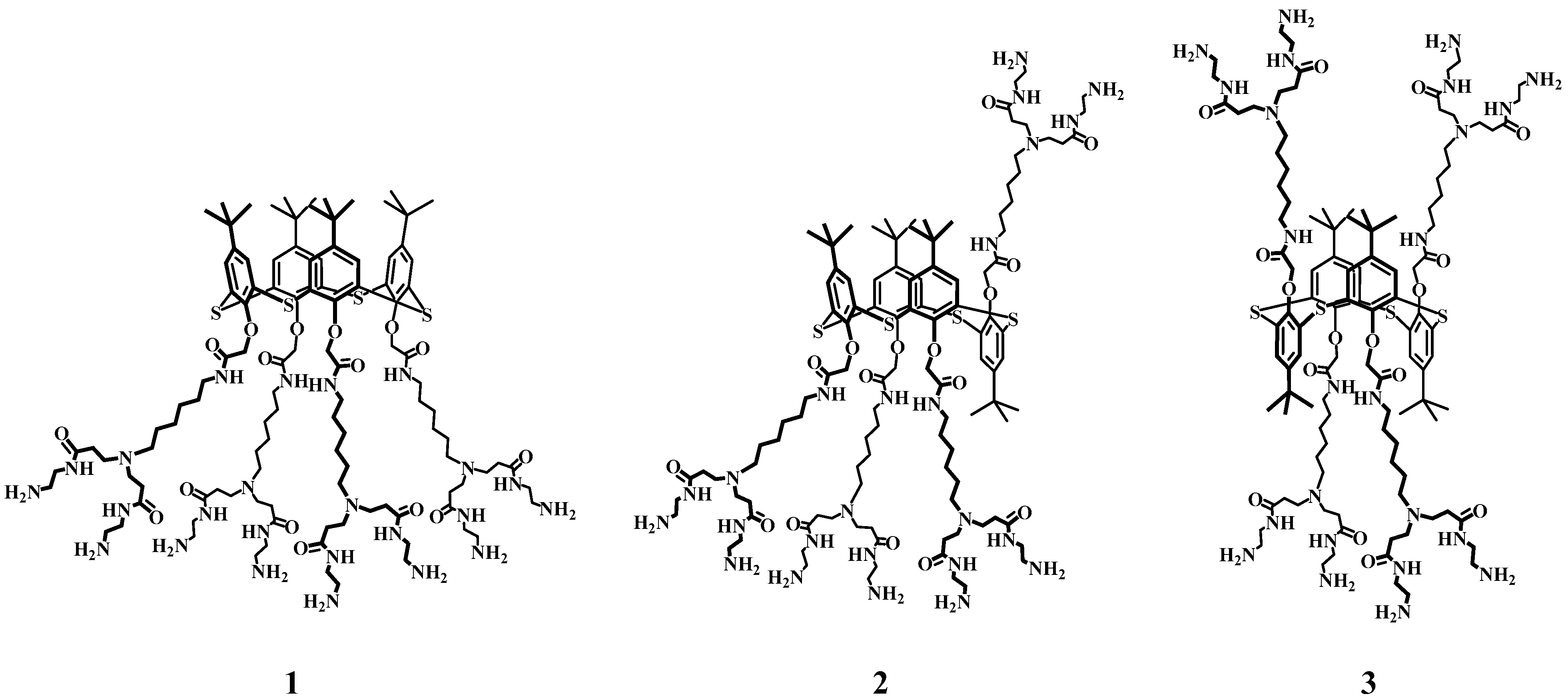
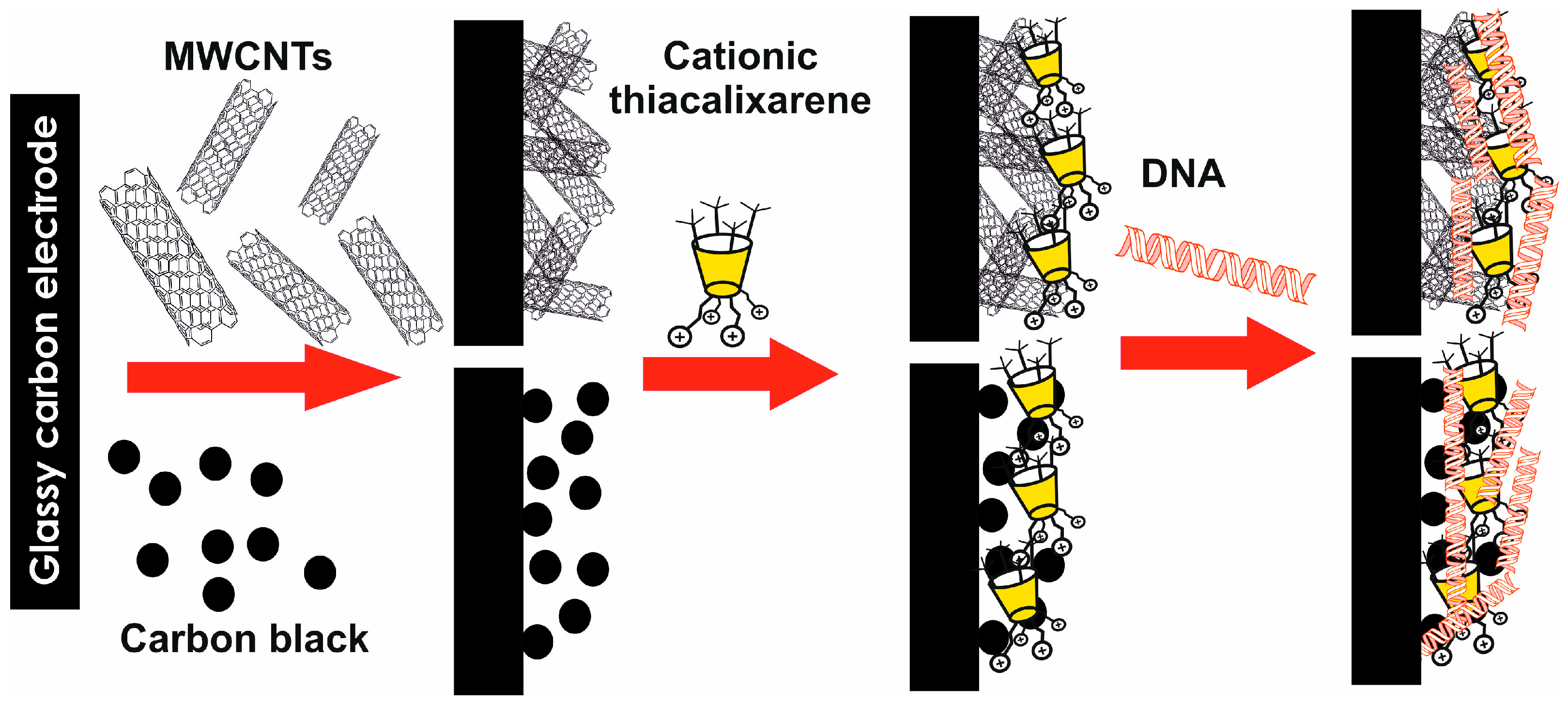

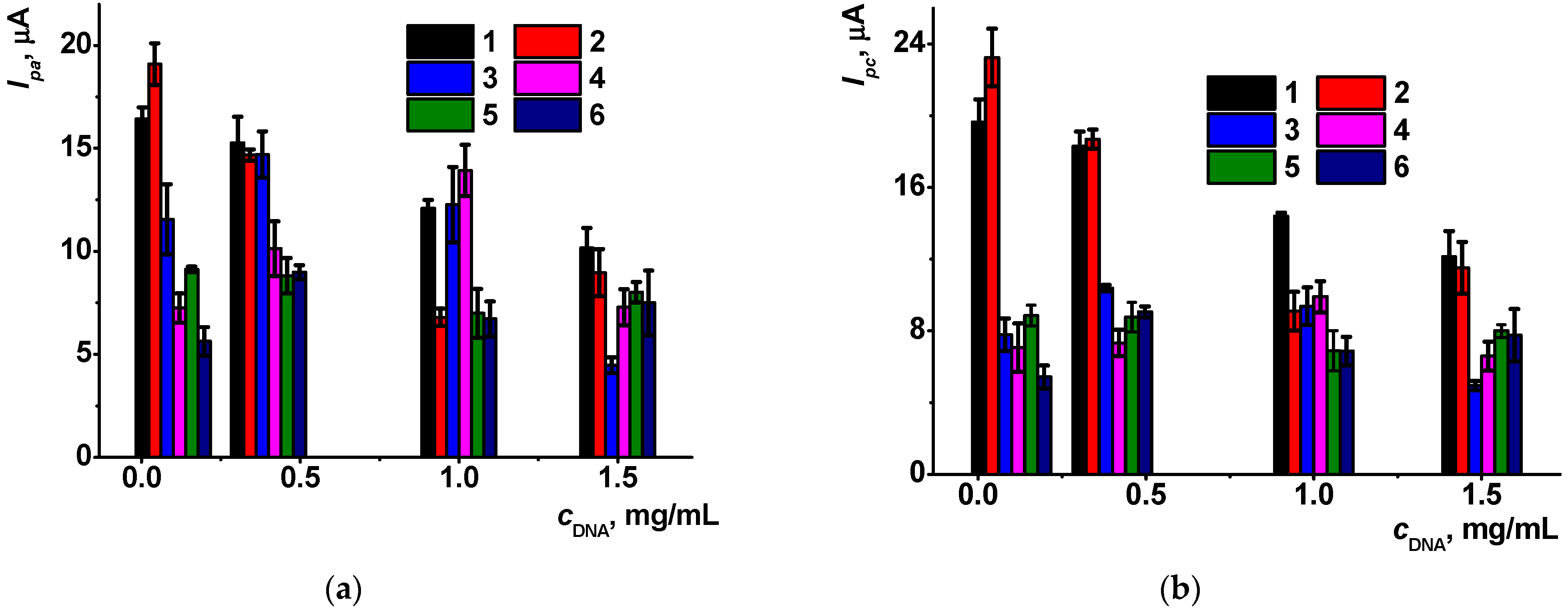
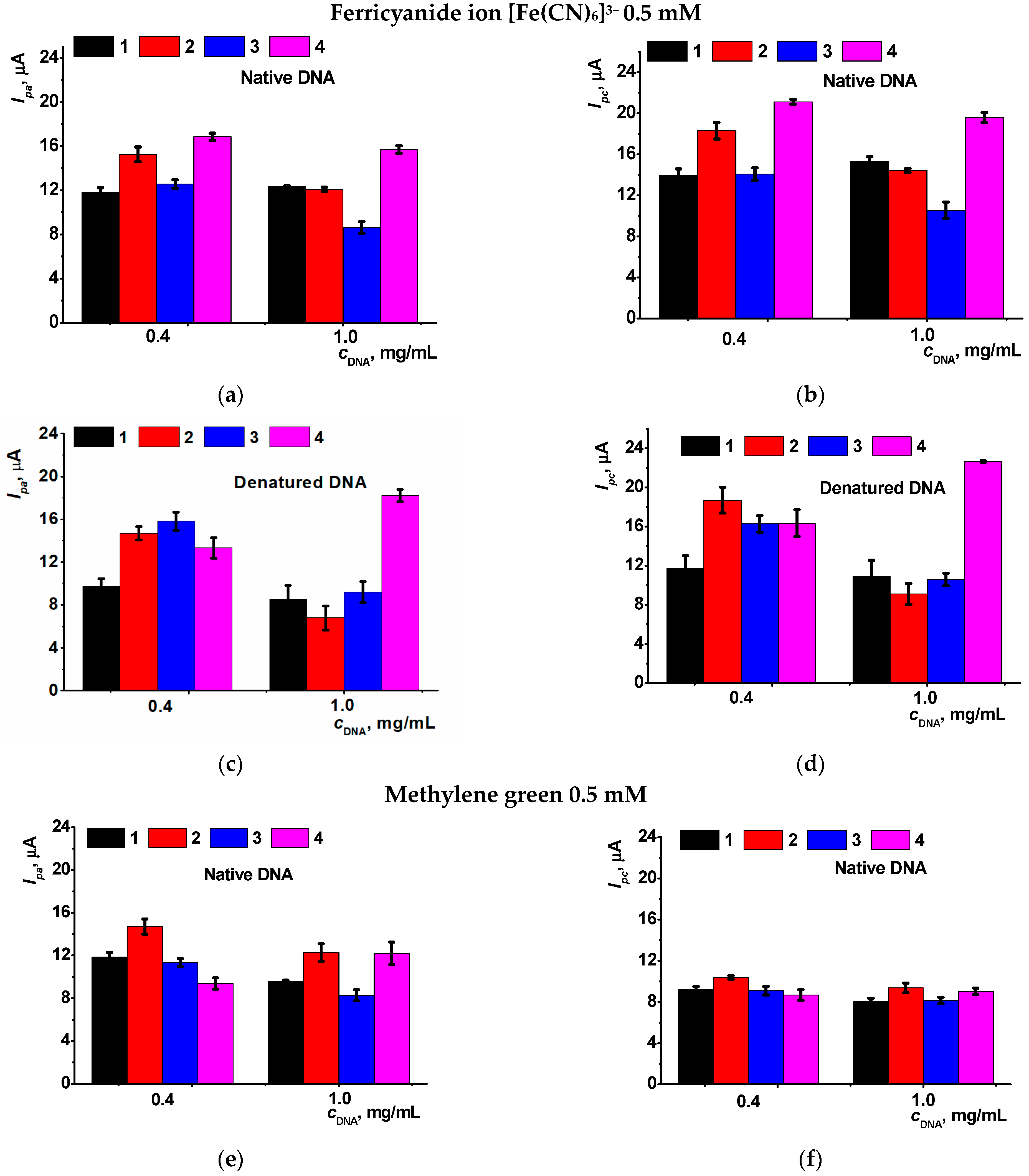
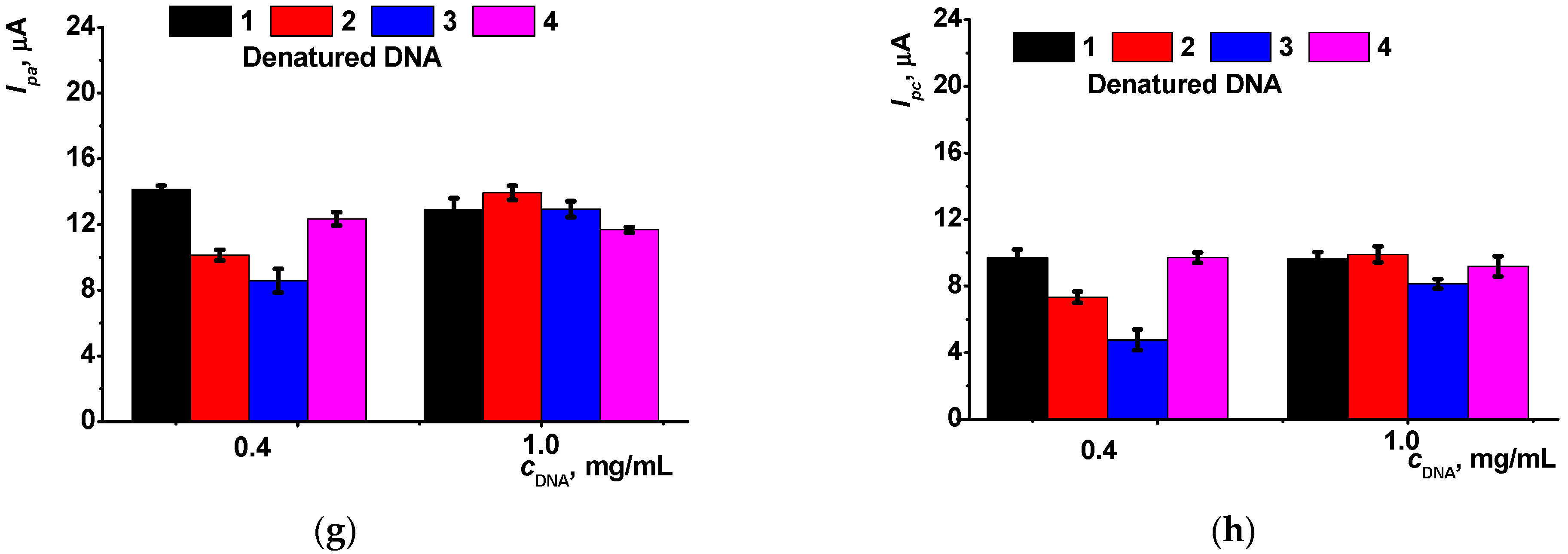
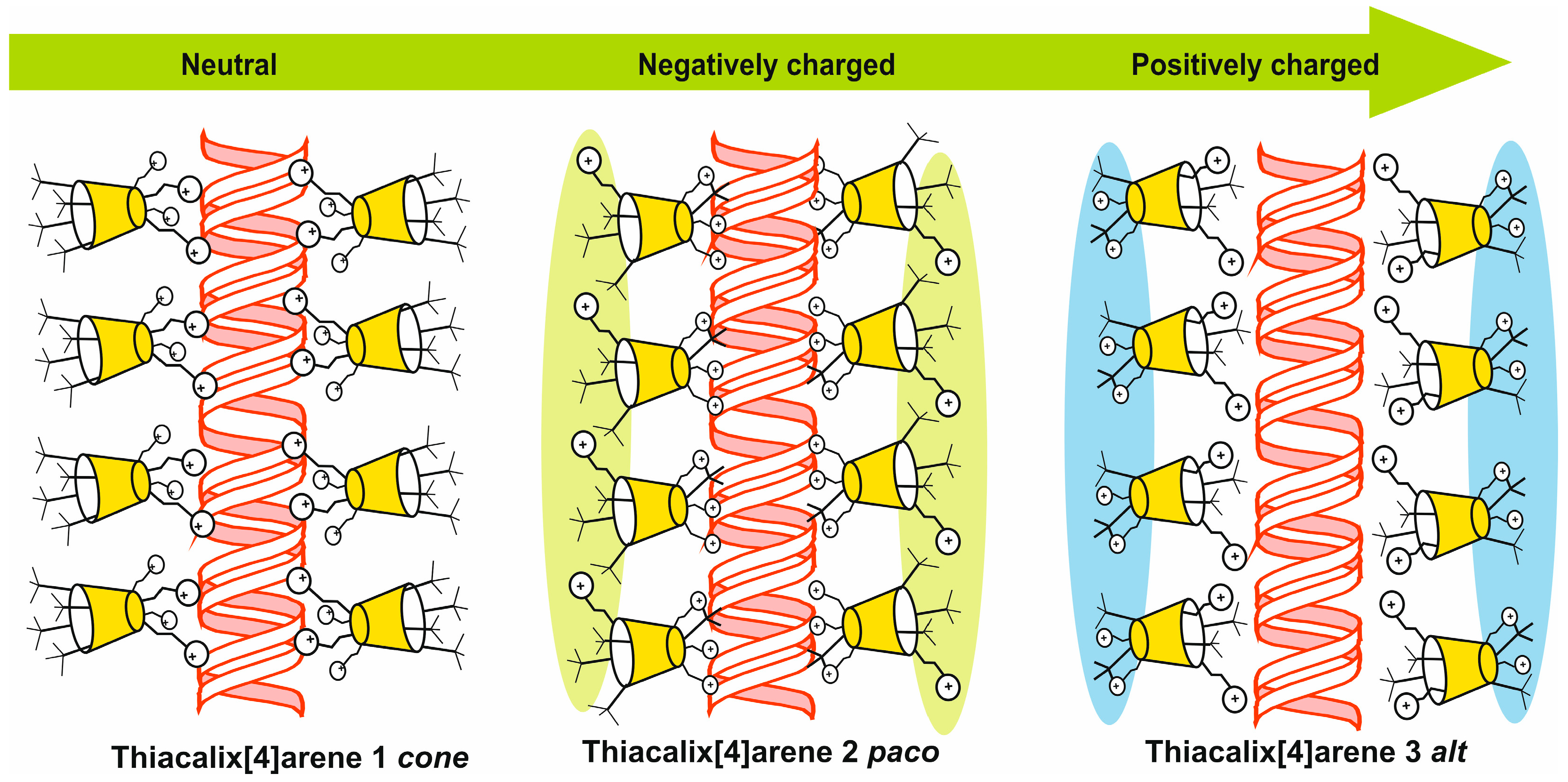

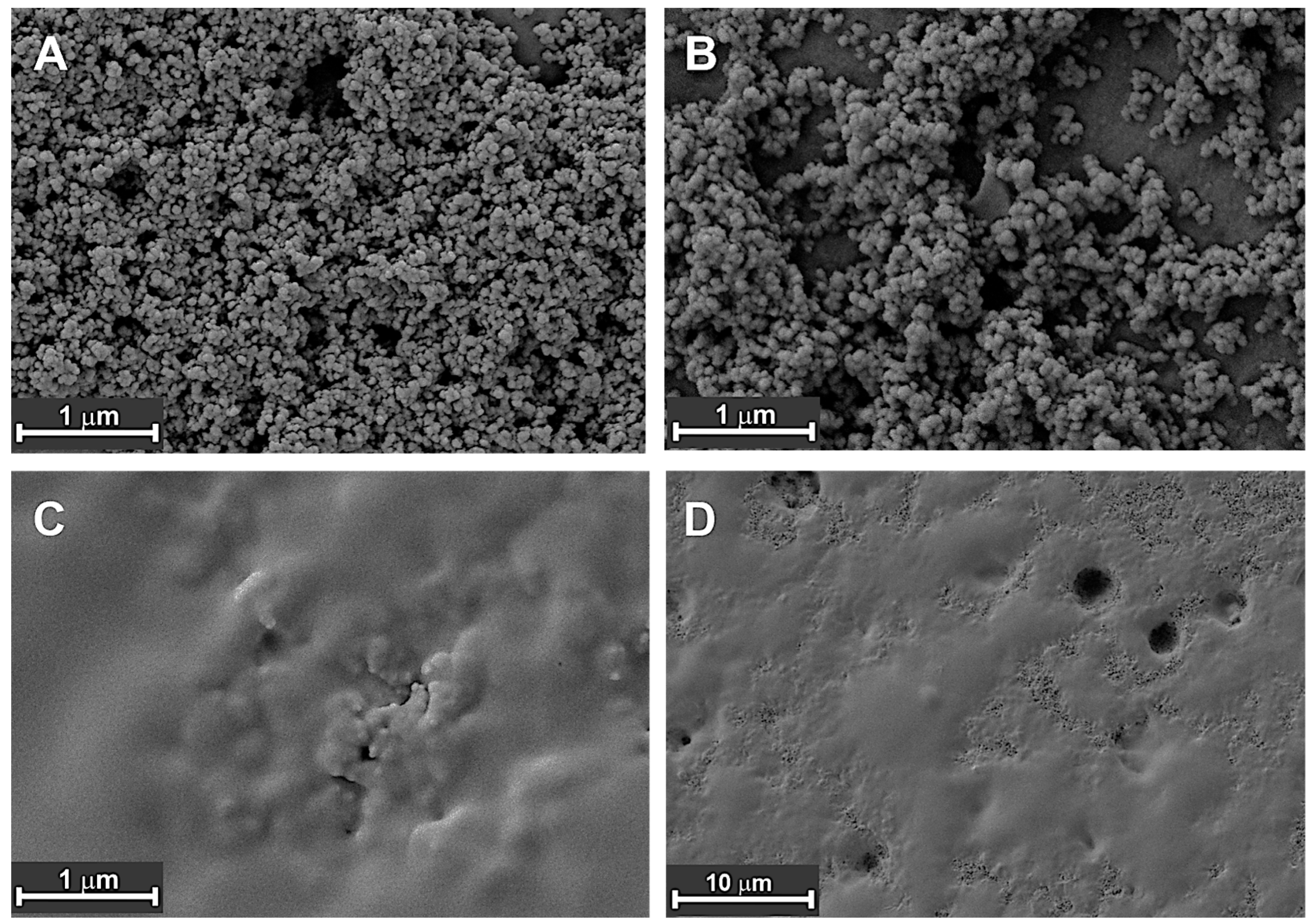
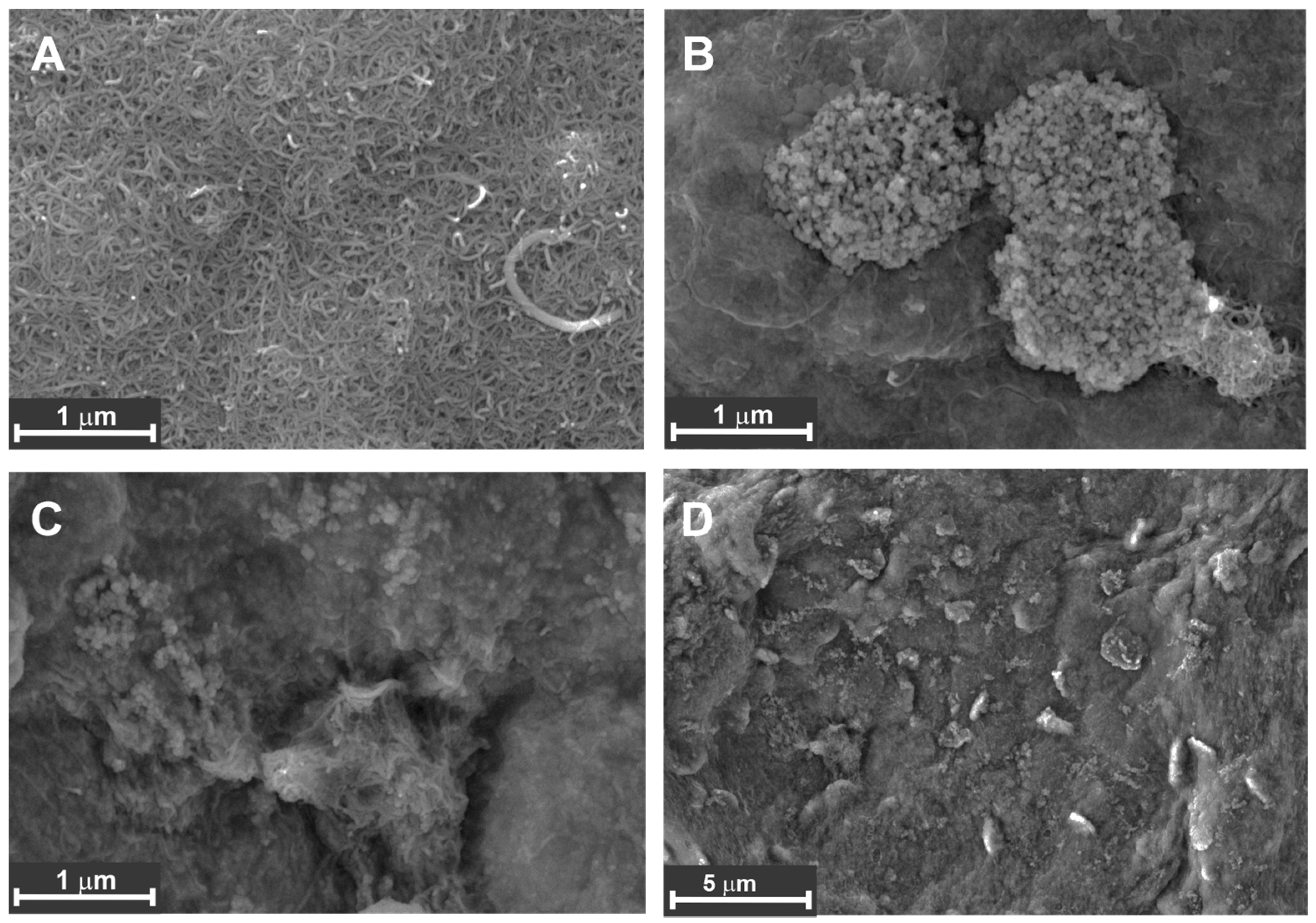


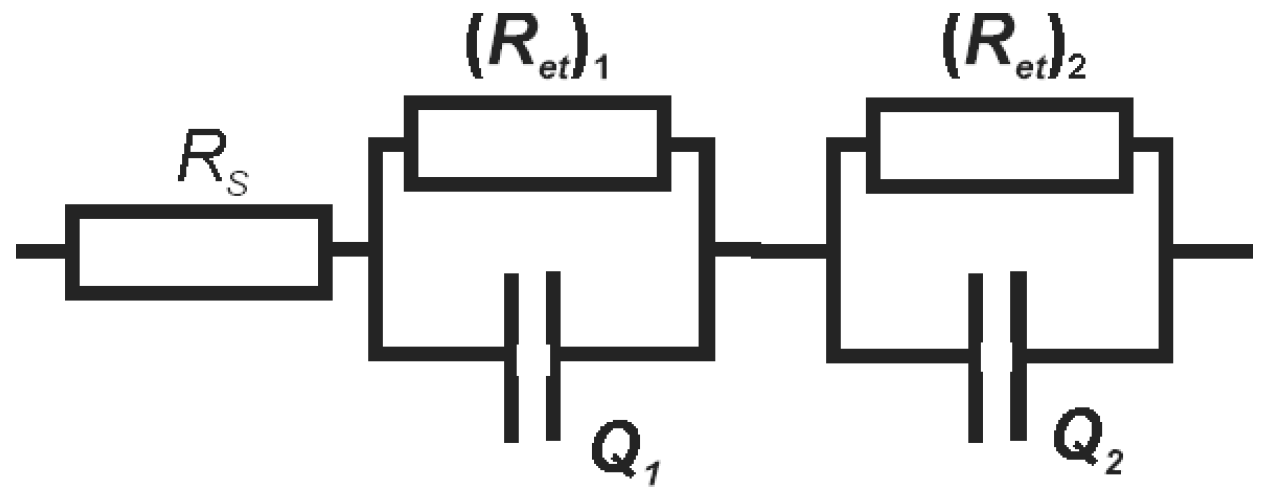


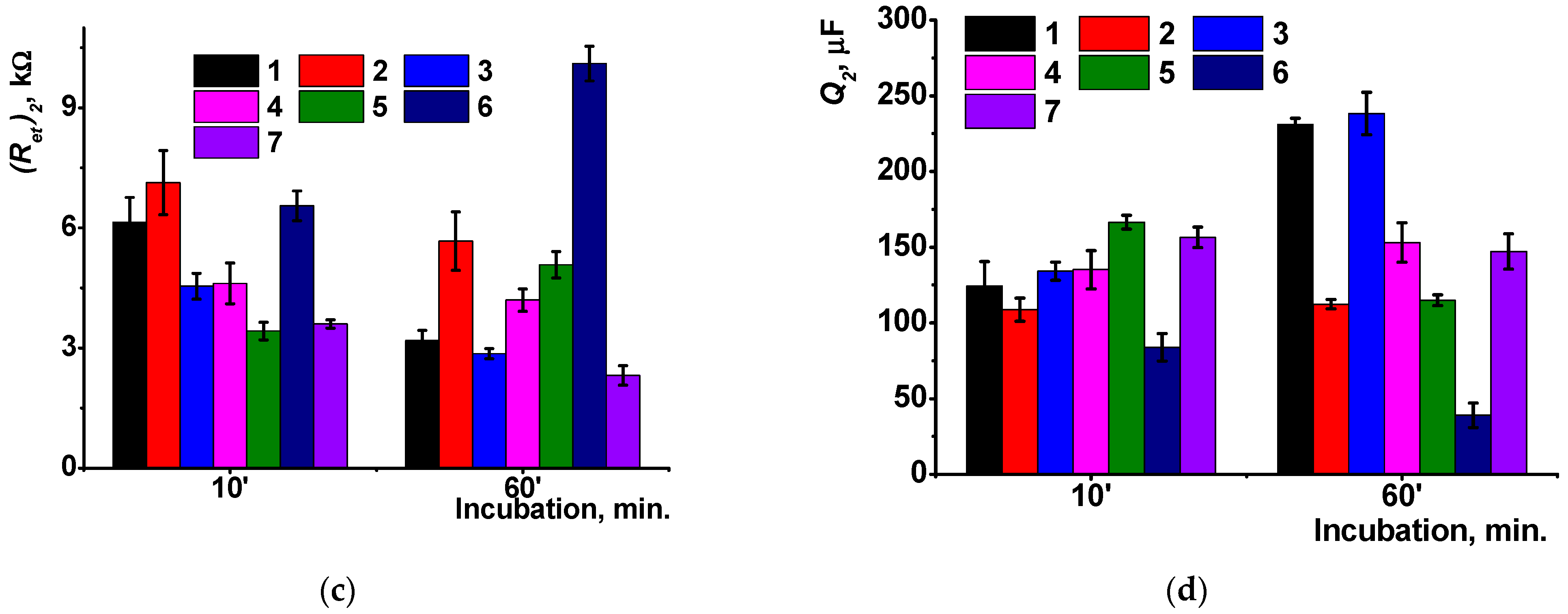

| DNA Coating | Rs, Ω | Electrode–Modifier Interface | Modifier–Solution Interface | |||||
|---|---|---|---|---|---|---|---|---|
| R2, Ω | Q2, μF | N2 | R1, Ω | Q1, μF | N1 | χ2 | ||
| Native DNA, 10 min. | 344 ± 21 | 1300 ± 120 | 30 ± 6 | 0.9995 | 4612 ± 2100 | 135 ± 224 | 0.9998 | 0.007 |
| Native DNA, 60 min. | 328 ± 21 | 1260 ± 126 | 22 ± 5 | 0.9993 | 4200 ± 270 | 153 ± 53 | 0.9997 | 0.013 |
| Denatured DNA. 10 min. | 344 ± 16 | 1117 ± 104 | 13 ± 5 | 0.9998 | 3420 ± 212 | 166 ± 44 | 0.9998 | 0.008 |
| Denatured DNA. 60 min. | 360 ± 18 | 2215 ± 80 | 6± 1 | 0.9994 | 5080 ± 280 | 115 ± 16 | 0.9996 | 0.008 |
| Oxidized DNA, 10 min. | 353 ± 30 | 1365 ± 122 | 6 ± 1 | 0.9992 | 6550 ± 570 | 84 ± 10 | 0.9996 | 0.001 |
| Oxidized DNA, 60 min. | 340 ± 25 | 3076 ± 166 | 11 ± 2 | 0.9996 | 10105 ± 432 | 79 ± 18 | 0.9998 | 0.007 |
| Modifier | Signal Measurement Mode | LOD | Ref. |
|---|---|---|---|
| Polyaniline | CV, [Fe(CN)6]3− redox indicator | 10 pM | [42] |
| Poly(Neutral red) | CV (Neutral red), EIS ([Fe(CN)6]3− redox indicator) | 0.05 nM (Neutral red), 0.1 nM (EIS) | [43] |
| Poly(Azure B) | CV (poly(Azure B) | 70 pM | [44] |
| Poly(Azure A) | CV (poly(Azure A) | 0.03–0.3 pM | [45] |
| Pillar[5]arene—poly(Methylene blue)—poly(Neutral red) | CV (Neutral red) | 0.13 pM | [46] |
| Poly(proflavine) | EIS ([Fe(CN)6]3− redox indicator) | 0.3 nM | [47] |
| Single-walled carbon nanotubes | DPV (guanine oxidation in DNA molecules) | 0.6 nM | [48] |
| Pt and Ag nanoparticles | DPV (guanine oxidation in DNA molecules) | 0.1 ppm | [49] |
| Acridine Yellow | CV | 0.07 pM | [50] |
| Poly(Azure B—proflavine) | EIS ([Fe(CN)6]3− redox indicator) | 0.01 nM | [51] |
| Macrocyclic dendrimers on thiacalix[4]arene core | CV, [Fe(CN)6]3− redox indicator | 1–10 pM | This work |
Disclaimer/Publisher’s Note: The statements, opinions and data contained in all publications are solely those of the individual author(s) and contributor(s) and not of MDPI and/or the editor(s). MDPI and/or the editor(s) disclaim responsibility for any injury to people or property resulting from any ideas, methods, instructions or products referred to in the content. |
© 2023 by the authors. Licensee MDPI, Basel, Switzerland. This article is an open access article distributed under the terms and conditions of the Creative Commons Attribution (CC BY) license (https://creativecommons.org/licenses/by/4.0/).
Share and Cite
Kulikova, T.; Shamagsumova, R.; Rogov, A.; Stoikov, I.; Padnya, P.; Shiabiev, I.; Evtugyn, G. Electrochemical DNA-Sensor Based on Macrocyclic Dendrimers with Terminal Amino Groups and Carbon Nanomaterials. Sensors 2023, 23, 4761. https://doi.org/10.3390/s23104761
Kulikova T, Shamagsumova R, Rogov A, Stoikov I, Padnya P, Shiabiev I, Evtugyn G. Electrochemical DNA-Sensor Based on Macrocyclic Dendrimers with Terminal Amino Groups and Carbon Nanomaterials. Sensors. 2023; 23(10):4761. https://doi.org/10.3390/s23104761
Chicago/Turabian StyleKulikova, Tatjana, Rezeda Shamagsumova, Alexey Rogov, Ivan Stoikov, Pavel Padnya, Igor Shiabiev, and Gennady Evtugyn. 2023. "Electrochemical DNA-Sensor Based on Macrocyclic Dendrimers with Terminal Amino Groups and Carbon Nanomaterials" Sensors 23, no. 10: 4761. https://doi.org/10.3390/s23104761
APA StyleKulikova, T., Shamagsumova, R., Rogov, A., Stoikov, I., Padnya, P., Shiabiev, I., & Evtugyn, G. (2023). Electrochemical DNA-Sensor Based on Macrocyclic Dendrimers with Terminal Amino Groups and Carbon Nanomaterials. Sensors, 23(10), 4761. https://doi.org/10.3390/s23104761








